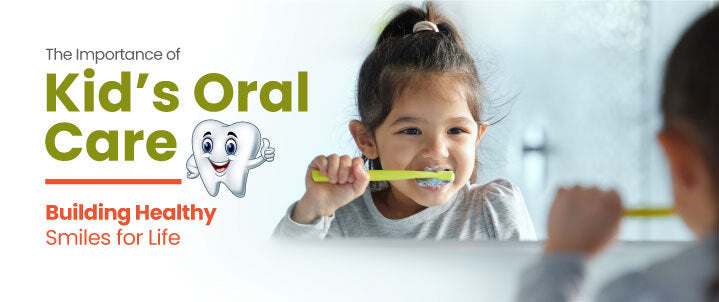
The Importance of Kid’s Oral Care: Building Healthy Smiles for Life
There’s nothing quite as heartwarming as a child’s beaming smile. It’s a reflection of their happiness, innocence, and pure joy. But beyond those giggles and tiny teeth lies something even more important, a foundation for lifelong health. Oral care in childhood isn’t just about avoiding cavities, it plays a role in speech, nutrition, self-confidence, and even how their permanent teeth grow in.
Yet, despite its importance, about 20% of children aged 5–11 have at least one untreated cavity, according to the CDC. That’s one in five kids dealing with pain that could have been prevented!
As parents, caregivers, and well-wishers, it’s our job to make sure their smiles stay bright and healthy. Let’s dive into why oral care matters, what happens when it’s neglected, and how to make brushing and flossing something your child actually enjoys.
Why Kids’ Oral Care Matters
1. Baby Teeth Are More Important Than You Think
Just because they’re “temporary” doesn’t mean baby teeth don’t matter. These little teeth help kids chew food properly, speak clearly, and most importantly, hold space for their adult teeth. If they fall out too soon due to decay, it can cause crowding and misalignment, leading to costly dental issues later.
2. No One Wants a Toothache (Especially Children!)
Tooth decay is the most common chronic disease in children and it’s completely preventable. An untreated cavity can be excruciating and may even lead to infections that require emergency dental work. Imagine trying to focus in school with a throbbing toothache, it’s no surprise that poor oral health is linked to lower academic performance.
3. Lifelong Habits Start Early
Brushing and flossing shouldn’t feel like a battle, it should be second nature. Kids who develop solid oral hygiene routines early are far more likely to carry them into adulthood, reducing their risk of gum disease, heart conditions, and diabetes, all of which have been linked to poor oral health.
What Happens When Oral Care Is Neglected?
Ignoring your child’s dental health can have serious consequences, including:
-
Cavities & Gum Disease: Plaque buildup from sugary foods weakens enamel and inflames gums.
-
Poor Nutrition: A painful tooth makes it hard for kids to eat healthy foods like crunchy apples or nuts, limiting their diet.
-
Self-Esteem Struggles: Discolored, damaged, or missing teeth can make a child feel self-conscious, leading to teasing or shyness.
-
Long-Term Health Issues: Untreated oral infections can contribute to systemic health problems, including heart disease later in life.
How to Make Oral Care Fun for Kids
Let’s be real, getting a kid excited about brushing their teeth can feel like convincing a cat to take a bath. But with a little creativity, you can turn this daily task into a fun and engaging routine!
1. Make Brushing an Adventure
-
Superhero Mode: Let them be a “superhero” saving their teeth from the evil “sugar monsters.”
-
Brush to a Song: Play their favorite 2-minute tune while brushing to make it more interesting and engaging.
-
Let Them Pick Their Tools: A toothbrush with their favorite cartoon character? Check. A yummy strawberry-flavored toothpaste? Double check!
Make brushing time even more enjoyable with a natural toothpaste that’s free from artificial sweeteners and preservatives, like Mother Sparsh Kids’ Natural Toothpaste, available in delicious strawberry, blueberry and mix fruit flavors.

2. Be Their Role Model
Kids copy everything, good and bad. If they see you brushing and flossing happily, they’ll want to do it too. Make it a game, “Let’s see who can make the most toothpaste bubbles!”
3. Use Rewards (Without Bribing)
-
Sticker Chart: Each successful brushing session earns them a sticker. A full week? Maybe a little prize, like an extra bedtime story.
-
Praise & Encouragement: Instead of “Did you brush your teeth?” try, “Wow! Your teeth are so shiny today!”
4. Teach Through Stories & Play
-
Read Books About Dental Care: Try fun kid’s story books that encourage brushing or fun YouTube videos that explain brushing in a kid-friendly way.
-
Role-Playing Games: Have their stuffed animals “go to the dentist” for a check-up, or let them “brush” a doll’s teeth first.
5. Start Early & Supervise
Even before teeth appear, gently wipe your baby’s gums with a soft cloth. Once that first tooth pops up, introduce a baby toothbrush with a tiny amount of fluoride toothpaste (about the size of a grain of rice).
Keep supervising until age 7–8 to make sure they’re brushing thoroughly and not just chewing on the toothbrush.
6. Choose Smile-Friendly Foods
-
Cut back on sticky, sugary snacks and sodas that fuel cavity-causing bacteria.
-
Instead, offer crunchy fruits, cheese, and nuts, which help clean teeth and strengthen enamel.
7. Normalize Dentist Visits
The first dental visit should happen by their first birthday or when their first tooth appears. Pediatric dentists make the experience fun with toys, TV screens, and a warm environment. If you stay positive about it, your child will too!
Overcoming Common Challenges
“I Don’t Want to Brush!”
Instead of forcing it, give them choices: “Do you want to brush before or after your bedtime story?”
“I’m Scared of the Dentist!”
Read books about dentist visits, play pretend check-ups, and choose a fun dentist’s office with a kid-friendly atmosphere.
The Bottom Line
Your child’s oral health isn’t just about avoiding cavities, it’s about setting them up for a lifetime of confidence, health, and happy smiles. By making dental care an enjoyable part of their daily routine, you’re not just protecting their teeth; you’re teaching them to take pride in their well-being.
So, grab that superhero toothbrush, turn up the music, and let’s make brushing time the best two minutes of their day!





